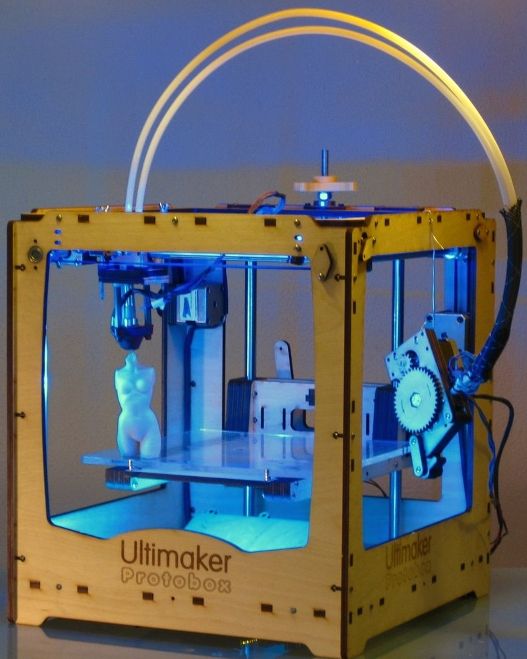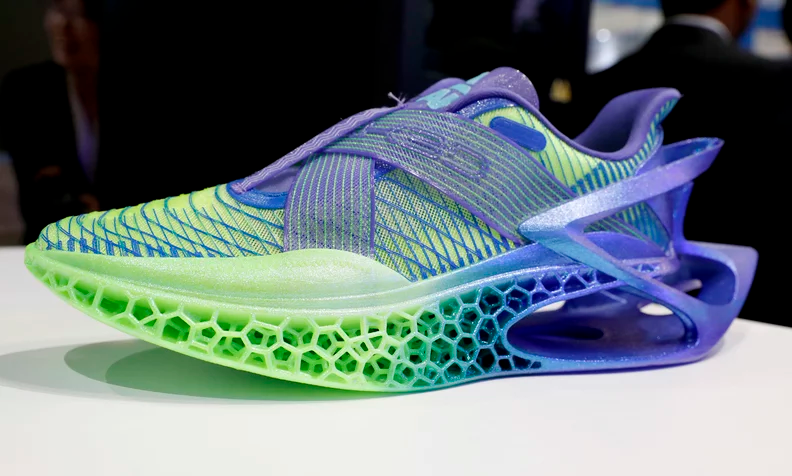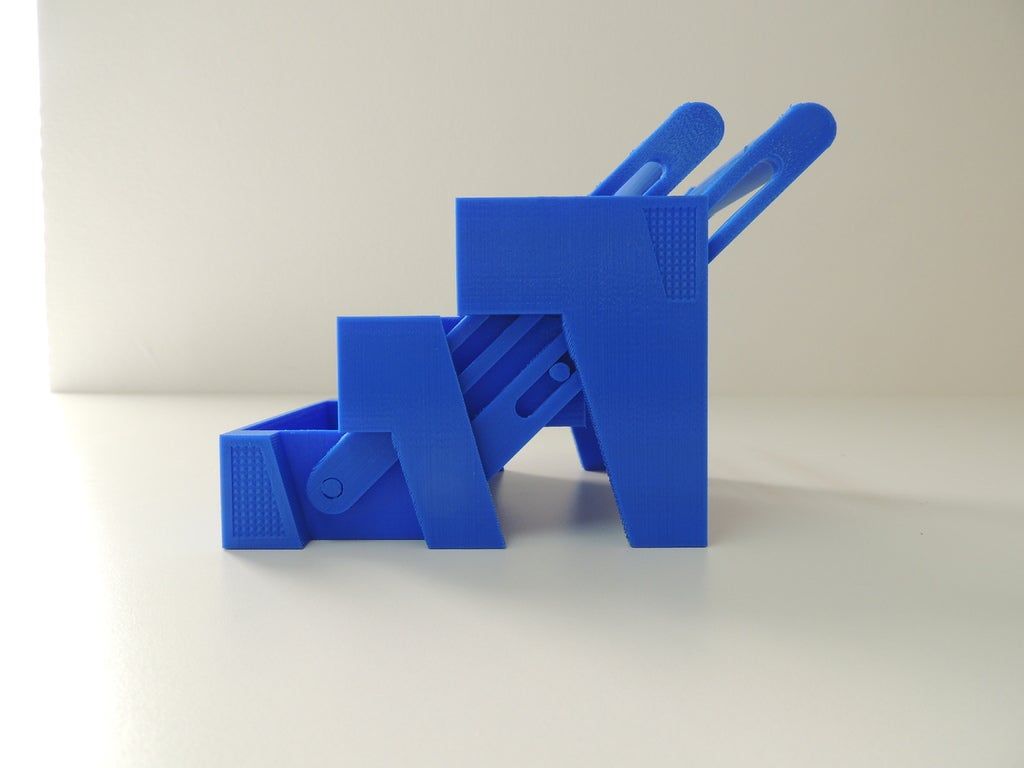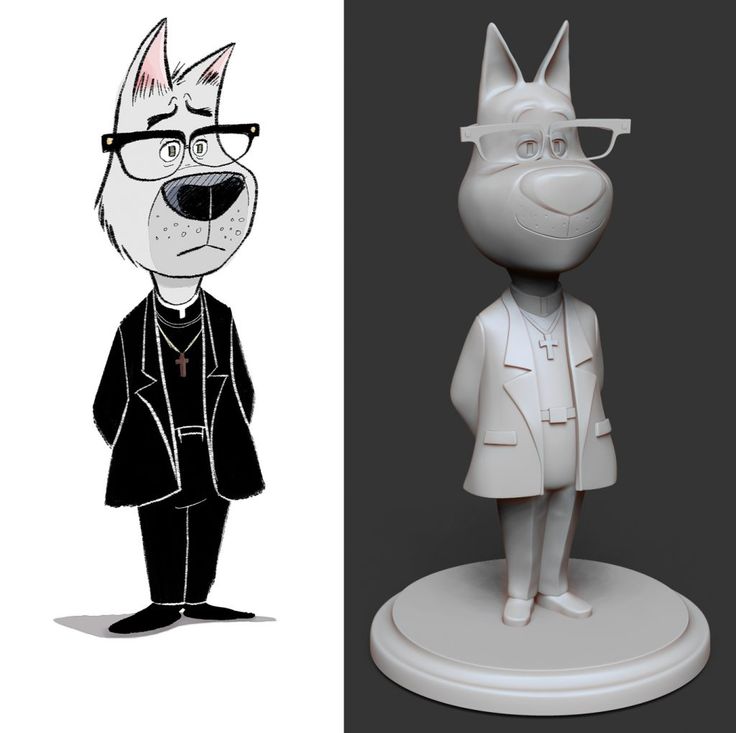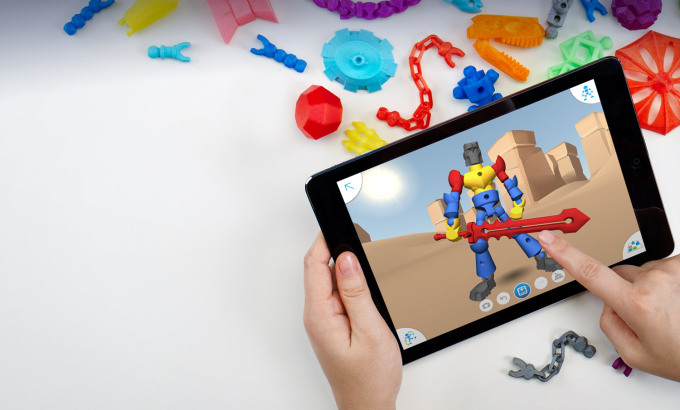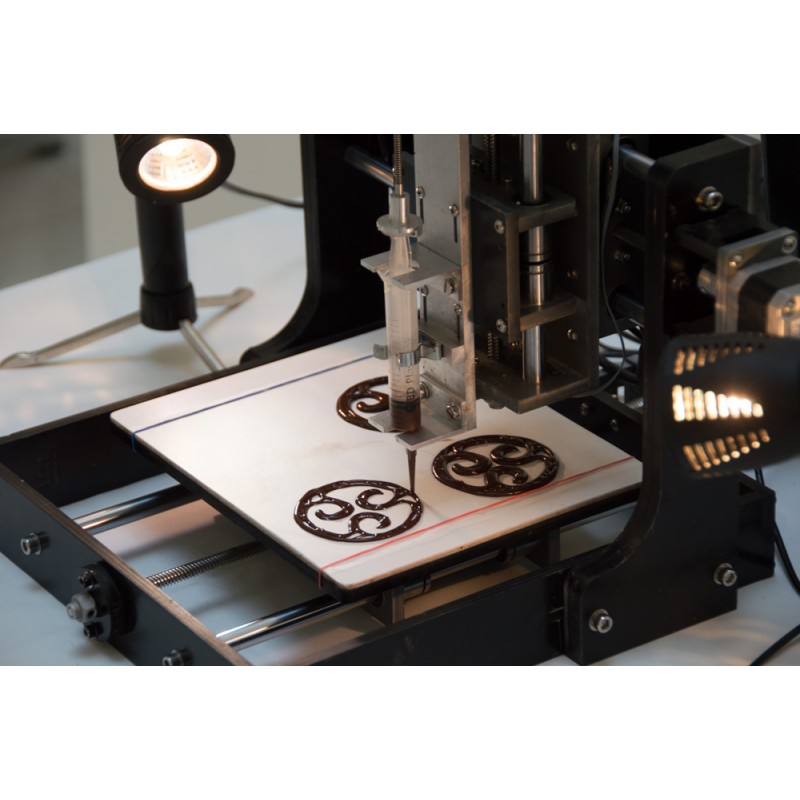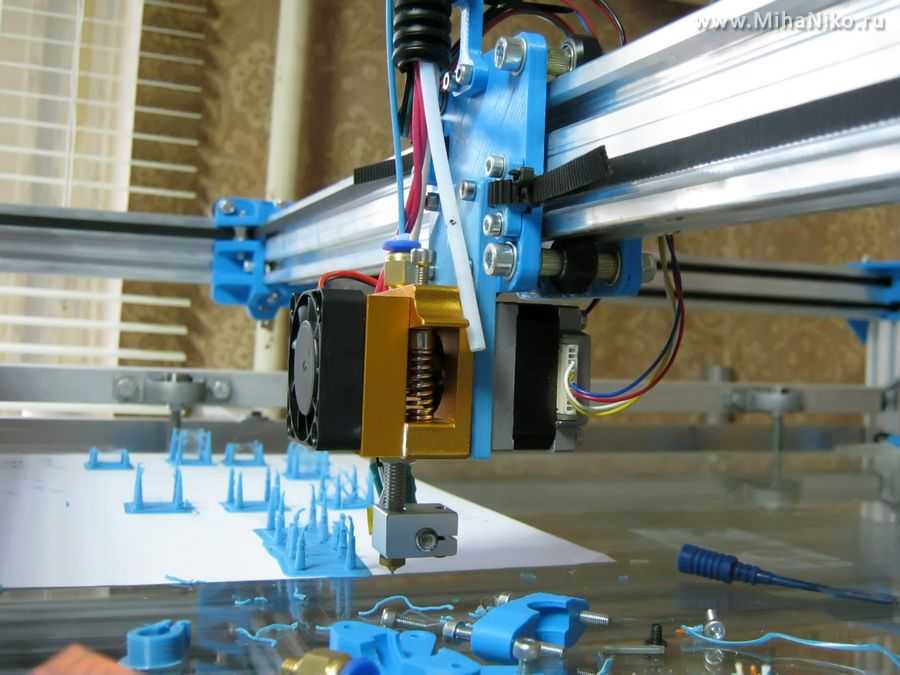New technology in 3d printing
New 3D printer promises faster, multi-material creations
Stanford engineers have designed a method of 3D printing that is 5 to 10 times faster than the quickest high-resolution printer currently available and is capable of using multiple types of resin in a single object.
By Laura Castañón
Advancements in 3D printing have made it easier for designers and engineers to customize projects, create physical prototypes at different scales, and produce structures that can’t be made with more traditional manufacturing techniques. But the technology still faces limitations – the process is slow and requires specific materials which, for the most part, must be used one at a time.
A model of Kyiv’s Saint Sophia Cathedral in the blue and yellow of the Ukrainian flag, made using the iCLIP method for 3D printing, which allows for the use of multiple types – or colors – of resin in a single object. (Image credit: William Pan)
Researchers at Stanford have developed a method of 3D printing that promises to create prints faster, using multiple types of resin in a single object. Their design, published recently in Science Advances, is 5 to 10 times faster than the quickest high-resolution printing method currently available and could potentially allow researchers to use thicker resins with better mechanical and electrical properties.
“This new technology will help to fully realize the potential of 3D printing,” says Joseph DeSimone, the Sanjiv Sam Gambhir Professor in Translational Medicine and professor of radiology and of chemical engineering at Stanford and corresponding author on the paper. “It will allow us to print much faster, helping to usher in a new era of digital manufacturing, as well as to enable the fabrication of complex, multi-material objects in a single step.”
Controlling the flow of resin
The new design improves on a method of 3D printing created by DeSimone and his colleagues in 2015 called continuous liquid interface production, or CLIP.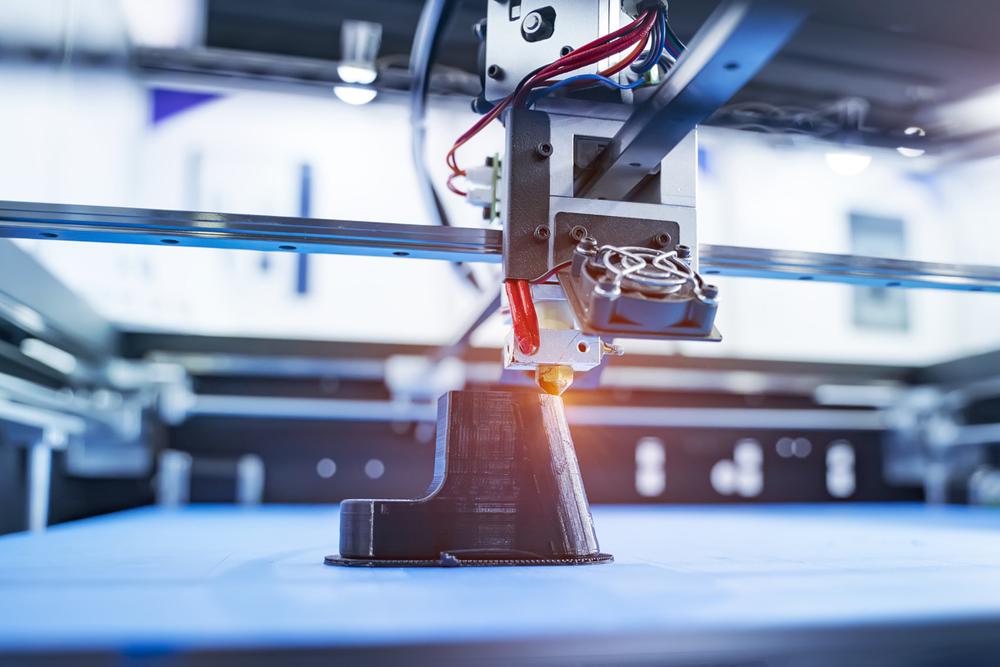 CLIP printing looks like it belongs in a science fiction movie – a rising platform smoothly pulls the object, seemingly fully formed, from a thin pool of resin. The resin at the surface is hardened into the right shape by a sequence of UV images projected through the pool, while a layer of oxygen prevents curing at the bottom of the pool and creates a “dead zone” where the resin remains in liquid form.
CLIP printing looks like it belongs in a science fiction movie – a rising platform smoothly pulls the object, seemingly fully formed, from a thin pool of resin. The resin at the surface is hardened into the right shape by a sequence of UV images projected through the pool, while a layer of oxygen prevents curing at the bottom of the pool and creates a “dead zone” where the resin remains in liquid form.
The dead zone is the key to CLIP’s speed. As the solid piece rises, the liquid resin is supposed to fill in behind it, allowing for smooth, continuous printing. But this doesn’t always happen, especially if the piece rises too quickly or the resin is particularly viscous. With this new method, called injection CLIP, or iCLIP, the researchers have mounted syringe pumps on top of the rising platform to add additional resin at key points.
“The resin flow in CLIP is a very passive process – you’re just pulling the object up and hoping that suction can bring material to the area where it’s needed,” says Gabriel Lipkowitz, a PhD student in mechanical engineering at Stanford and lead author on the paper.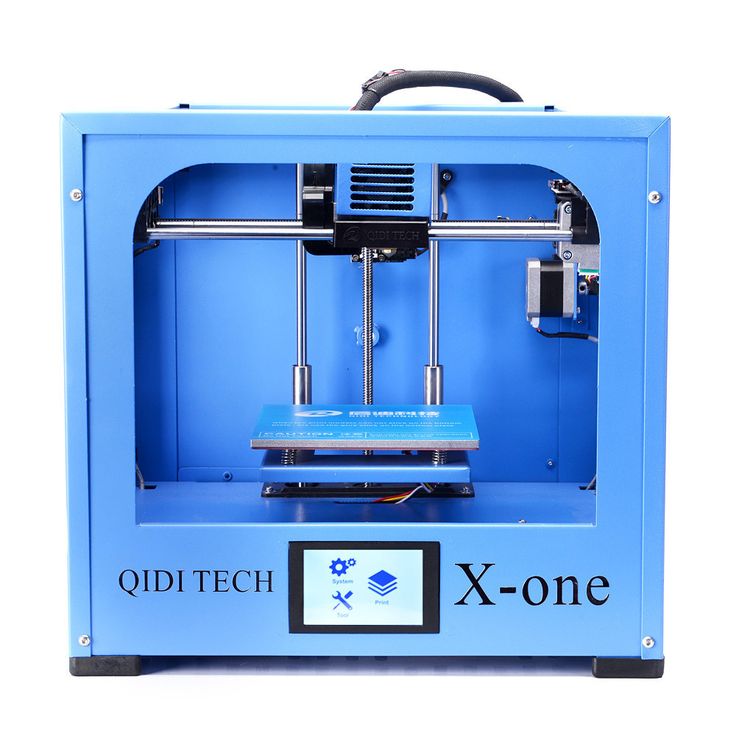 “With this new technology, we actively inject resin onto the areas of the printer where it’s needed.”
“With this new technology, we actively inject resin onto the areas of the printer where it’s needed.”
The resin is delivered through conduits that are printed simultaneously with the design. The conduits can be removed after the object is completed or they can be incorporated into the design the same way that veins and arteries are built into our own body.
Multi-material printing
By injecting additional resin separately, iCLIP presents the opportunity to print with multiple types of resin over the course of the printing process – each new resin simply requires its own syringe. The researchers tested the printer with as many as three different syringes, each filled with resin dyed a different color. They successfully printed models of famous buildings from several countries in the color of each country’s flag, including Saint Sophia Cathedral in the blue and yellow of the Ukrainian flag and Independence Hall in American red, white, and blue.
“The ability to make objects with variegated material or mechanical properties is a holy grail of 3D printing,” Lipkowitz says.![]() “The applications range from very efficient energy-absorbing structures to objects with different optical properties and advanced sensors.”
“The applications range from very efficient energy-absorbing structures to objects with different optical properties and advanced sensors.”
Having successfully demonstrated that iCLIP has the potential to print with multiple resins, DeSimone, Lipkowitz, and their colleagues are working on software to optimize the design of the fluid distribution network for each printed piece. They want to ensure that designers have fine control over the boundaries between resin types and potentially speed up the printing process even further.
“A designer shouldn’t have to understand fluid dynamics to print an object extremely quickly,” Lipkowitz says. “We’re trying to create efficient software that can take a part that a designer wants to print and automatically generate not only the distribution network, but also determine the flow rates to administer different resins to achieve a multi-material goal.”
DeSimone is a member of Stanford Bio-X, the Wu Tsai Human Performance Alliance, and the Stanford Cancer Institute; he is a faculty fellow of Stanford’s Sarafan ChEM-H; and he holds appointments in the departments of Radiology and Chemical Engineering.
Additional Stanford co-authors of this research include Eric S. G. Shaqfeh, the Lester Levi Carter Professor in the School of Engineering and professor of chemical engineering and of mechanical engineering; senior research scientist Maria T. Dulay; postdoctoral scholars Kaiwen Hsiao and Brian Lee; graduate students Tim Samuelson, Ian Coates, and Harrison Lin; and undergraduate student William Pan. Other co-authors are from Sungkyunkwan University and Digital Light Innovations.
This work was funded by the Precourt Institute for Energy at Stanford, the Stanford Woods Institute for the Environment, and the National Science Foundation.
To read all stories about Stanford science, subscribe to the biweekly Stanford Science Digest.
Exploring Every 3D Printing Technology Available in 2022
3D printing is rapidly becoming one of the most popular DIY hobbies, with more than 2.2 million printers shipped around the globe in 2021 alone.
New types of 3D printing are always in active development, and the growing market for this technology is driving innovation, making many older printers look practically prehistoric.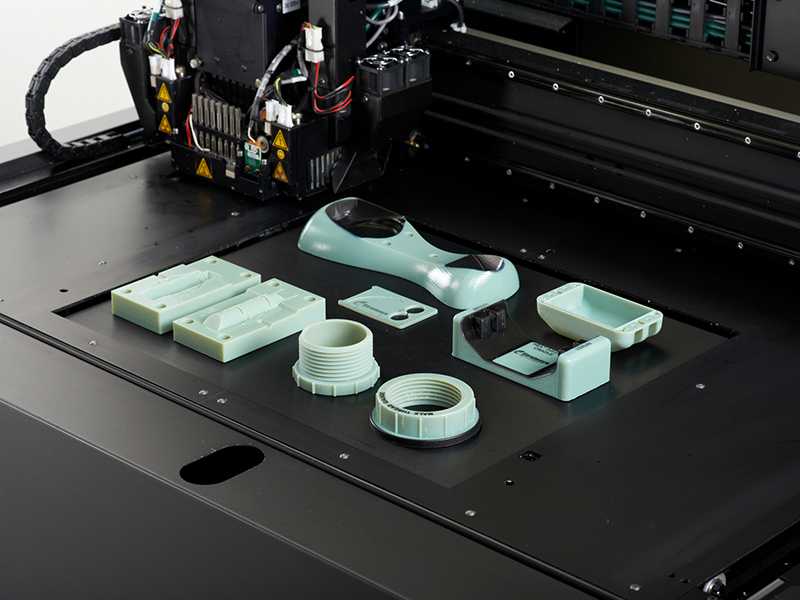
But what are the different types of 3D printing available in 2022? Let’s find out below.
How Many Types of 3D Printing Are There?
Most 3D printing enthusiasts will be aware of material extrusion (FDM), vat polymerization (SLA, DLP, and MSLA), and powder bed fusion (SLS and EBM). But, there are actually seven different types of 3D printing technology available for hobbyists and manufacturers in 2022. Sub-types can be found within each of these categories, making for a long list of different types of 3D printers available on today’s market.
- Material Extrusion
- Vat Polymerization
- Powder Bed Fusion
- Material Jetting
- Binder Jetting
- Direct Energy Deposition
- Sheet Lamination
What Are the 3 Main Types of 3D Printing?
While many types of 3D printers are available today, there are three main technologies that 3D printing enthusiasts use at home. This includes FDM (fused deposition modeling), SLA (selective laser sintering), and SLS (selective laser sintering).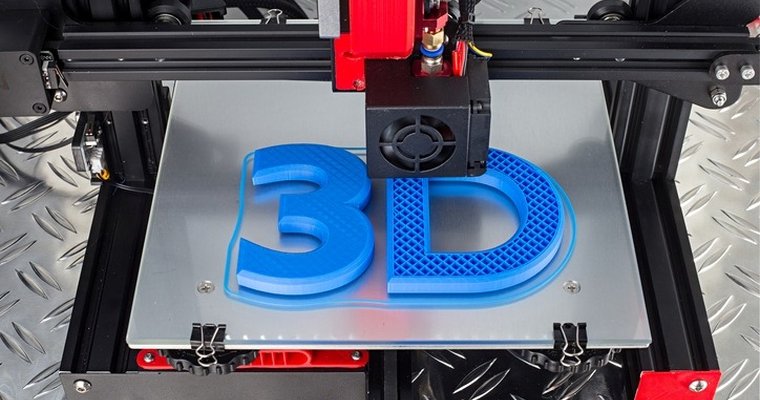
3D Printing Technology Available in 2022
Below you can find a collection of all the most essential 3D printing technologies available in 2022. This focuses on the 3D printer types that normal people can buy and use at home, but we have also included 3D printers that are available to manufacturers.
Types of 3D Printing: Material Extrusion
Image Credit: ESA/Wikimedia CommonsMaterial extrusion is the most popular type of 3D printing for home use. FDM (fused deposition modeling)/FFF (fused filament fabrication) is the only type of printer that falls into this category, but it’s worth keeping in mind that printers like this come in an array of shapes and sizes.
Printer Cost | Low to high |
Material Cost | Low to medium |
Available Materials | PLA, ABS, PET, PETG, TPU, Nylon, ASA, PC, HIPS, and many more. |
Home Suitability | Ideal for home use |
FDM/FFF 3D Printers
FDM/FFF 3D printers are affordable and relatively easy to work with, especially with modern advancements like heated beds and enclosures. FDM 3D printers work by laying down layer after layer of material using a gantry or set of actuators. The material comes in the form of a solid filament that is loaded onto the printer and passed through a heated extruder that causes it to melt.
Types of 3D Printing: Vat Polymerization
Unlike material extrusion, vat polymerization uses a liquid starting material that solidifies when exposed to light. Lasers and other types of precision lighting are used to cure photopolymer resins that sit in a vat, usually with a bed that slowly lifts the object as it is made. Vat polymerization 3D printing is known for producing incredibly detailed parts without noticeable layer lines, making SLA and DLP very different from FDM 3D printing.
Printer Cost | Low to high |
Material Cost | Medium to high |
Available Materials | Photopolymer resin |
Home Suitability | Suitable for home use |
SLA (Stereolithography) 3D Printers
First invented in 1986, SLA was the first 3D printing technology patented in the US. This type of printer has a vat of photopolymer resin, a set of mirrors called galvanometers, and a powerful laser as its main components. The laser and mirrors work in conjunction to cure specific parts of the resin to create a detailed model. Like FDM 3D printers, SLA printers form one layer at a time with a bed that moves into the position for the next layer.
DLP (Direct Light Processing) 3D Printers
DLP 3D printers are very similar to SLA printers, except they use a digital light projector rather than a laser to cure the resin.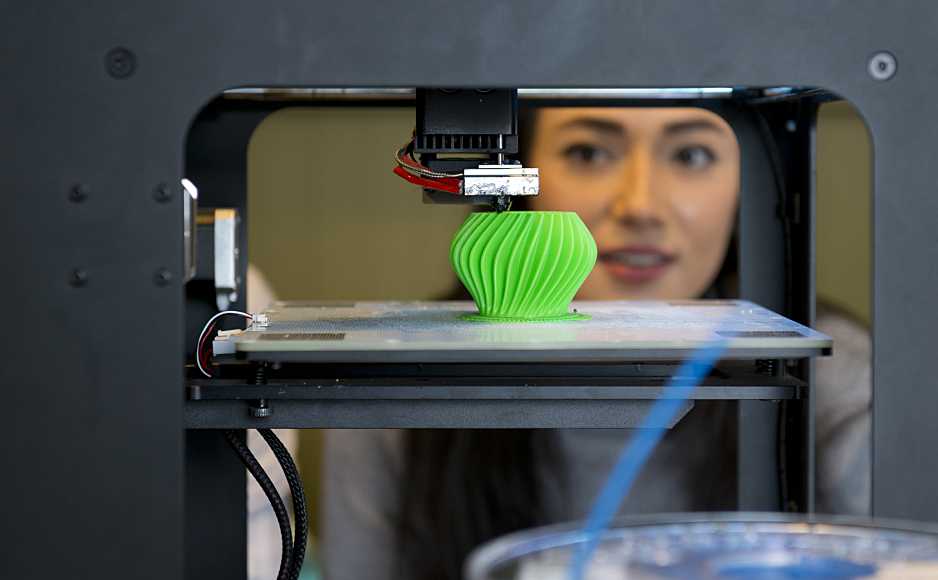 This has the advantage of speeding up print times, as digital light 3D printers can cure whole layers with a single flash of their light projectors rather than having to focus on single points.
This has the advantage of speeding up print times, as digital light 3D printers can cure whole layers with a single flash of their light projectors rather than having to focus on single points.
Other Types of Vat Polymerization 3D Printers
- Programmable Photopolymerization (P3)
- Masked Stereolithography (MSLA)
- High Area Rapid Printing (HARP)
- Lithography-based Metal Manufacturing (LMM)
- Light Enabled Additive Production (LEAP)
- Projection Micro Stereolithography (PµSL)
- Digital Composite Manufacturing (DCM)
Types of 3D Printing: Powder Bed Fusion
Credit: Shapeways/FlickrPowder bed fusion is unique in the sense that instead of using filament or resin, these printers use powdered materials that are fused by thermal energy. Not only does this open the doors to metal and ceramic 3D printing, but it also removes the need for annoying supports; the powder does the work for you.
Printer Cost | High |
Material Cost | Medium to high |
Available Materials | Polymer powders, metal powder, ceramic powders |
Home Suitability | Suitable for home use, but best for manufacturing |
SLS (Selective Laser Sintering) 3D Printers
Selective laser sintering 3D printers start each print by laying down a fine layer of polymer powder that is almost at its melting point on a heated bed. A laser is then used, in a similar fashion to SLA, to selectively fuse parts of the powder. Once a layer is complete, another layer of powder is added and the process starts again.
A laser is then used, in a similar fashion to SLA, to selectively fuse parts of the powder. Once a layer is complete, another layer of powder is added and the process starts again.
EBM (Electron Beam Melting) 3D Printers
EBM 3D printers work similarly to SLS printers, except they work with metal powders and use an electron beam rather than a laser. This beam has a higher energy density than a laser, enabling EBM printers to work faster than their counterparts while also sacrificing fine detail.
Other Types of Powder Bed Fusion 3D Printers
- Direct Metal Laser Sintering (DMLS)
- Selective Laser Melting (SLM)
- Multi-Jet Fusion (MJF)
Types of 3D Printing: Material Jetting (MJ)
Material jetting 3D printers work very similarly to a regular 2D printer. Liquid material is deposited onto a build plate and cured using lasers or digital light projectors, with precise jets laying the material down layer by layer.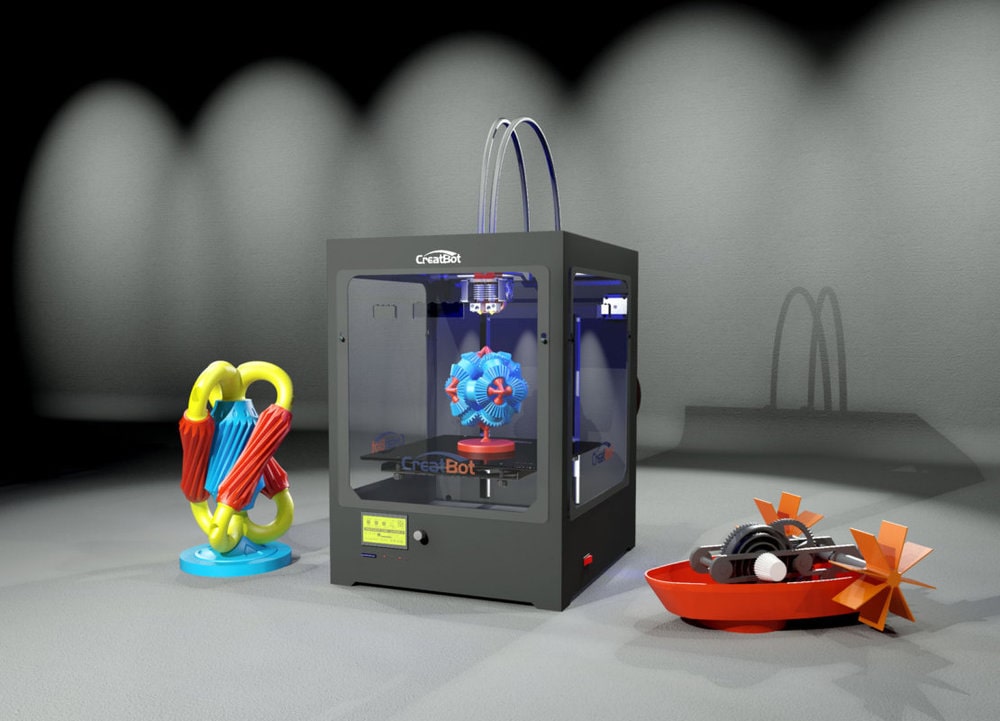 DOD MJ printers can even deposit both polymer and wax materials to make supports.
DOD MJ printers can even deposit both polymer and wax materials to make supports.
Printer Cost | High |
Material Cost | High |
Available Materials | Photopolymer resin |
Home Suitability | Not suitable for home use |
Types of Material Jetting 3D Printers
- Drop on Demand (DOD)
- NanoParticle Jetting (NPJ)
- ColorJet Printing (CJP)
Types of 3D Printing: Binder Jetting
Binder jetting is like a cross between material jetting and powder bed fusion. Layers of powered material are added to a build plate, with a nozzle jetting a binding material into specific places to build each layer of the finished model. Sand, metal, and polymers are all used for this process, though each material requires its own equipment to work with.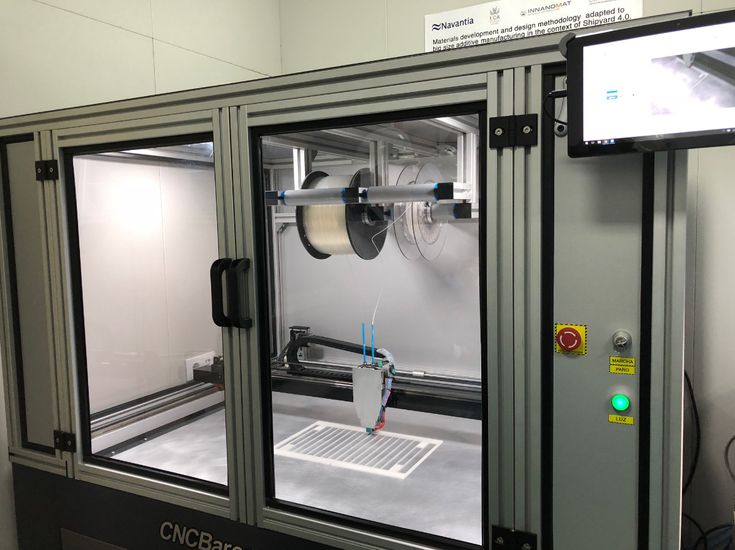
Printer Cost | High |
Material Cost | Low to high |
Available Materials | Sand, plastic, metal |
Home Suitability | Not suitable for home use |
Types of Binder Jetting 3D Printers
- Sand Binder Jetting
- Plastic Binder Jetting
- Metal Binder Jetting
Types of 3D Printing: Direct Energy Deposition
DED 3D printers work similarly to an FDM printer; a nozzle moves around a print bed while depositing material in layers to build a model. Rather than melted plastic filament, direct energy deposition 3D printers use metal powder or wire that is heated and fused as it leaves the nozzle. Printers like this will either have a laser, electron, or plasma beam to heat the material.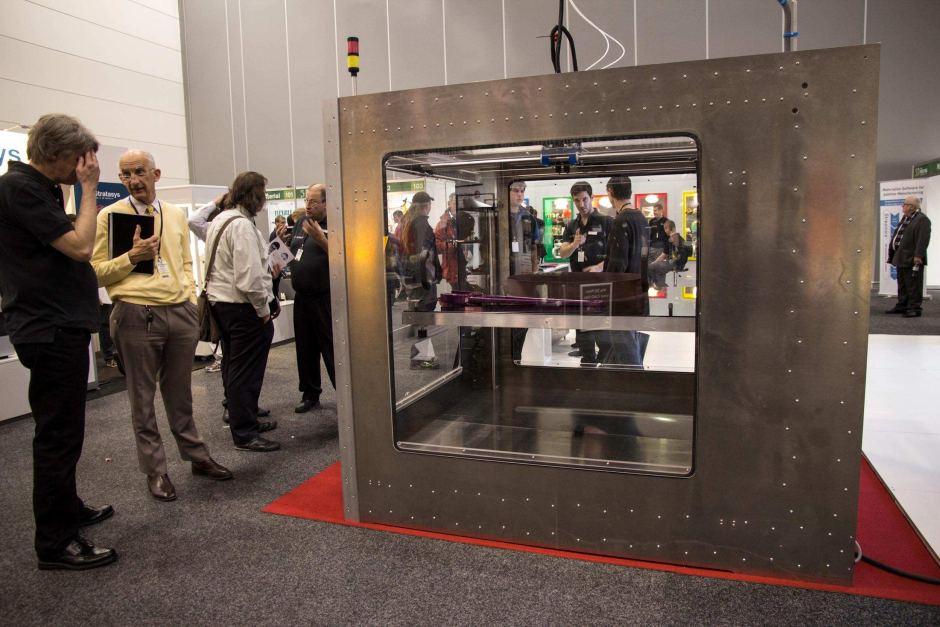
Printer Cost | Low to high |
Material Cost | Medium to high |
Available Materials | Photopolymer resin |
Home Suitability | Not suitable for home use |
Types of Direct Energy Deposition 3D Printers
- Electron Beam Additive Manufacturing (EBAM)
- Laser Engineered Net Shaping (LENS)
- Cold Spray
- Direct Metal Deposition (DMD)
- Wire Arc Additive Manufacturing (WAAM)
- Rapid Plasma Deposition (RPD)
Types of 3D Printing: Sheet Lamination
Sheet lamination 3D printers are unique in the world of 3D printing, as they can’t finish the pieces they make on their own. Layers of paper, plastic, or metal are laminated using glue, heat, or sound before a shape is cut from it using a laser cutter or CNC machine.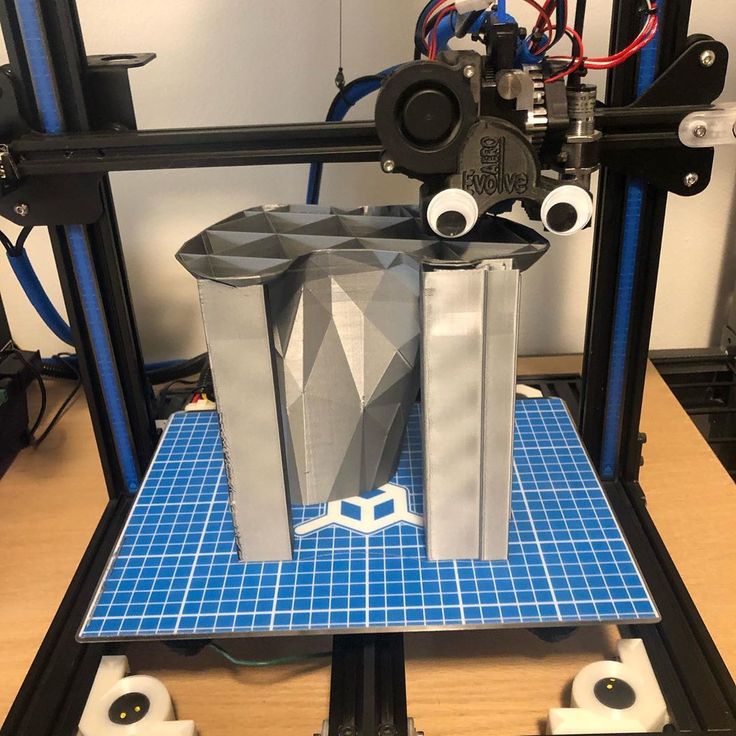 This 3D printing method is affordable and fast compared to other methods.
This 3D printing method is affordable and fast compared to other methods.
Printer Cost | Medium to high |
Material Cost | Low |
Available Materials | Paper, polymers, metal |
Home Suitability | Not suitable for home use |
Types of Sheet Lamination 3D Printers
- Laminated Object Manufacturing (LOM)
- Ultrasonic Consolidation (UC)
- Selective Lamination Composite Object Manufacturing (SLCOM)
- Plastic Sheet Lamination (PSL)
- Computer-Aided Manufacturing of Laminated Engineering Materials (CAM-LEM)
- Selective Deposition Lamination (SDL)
- Composite Based Additive Manufacturing (CBAM)
Choose the Right Type of 3D Printer for You
Most people will stick with FDM or vat polymerization 3D printers when it comes to home use, as they are the cheapest and easiest printers to buy and maintain.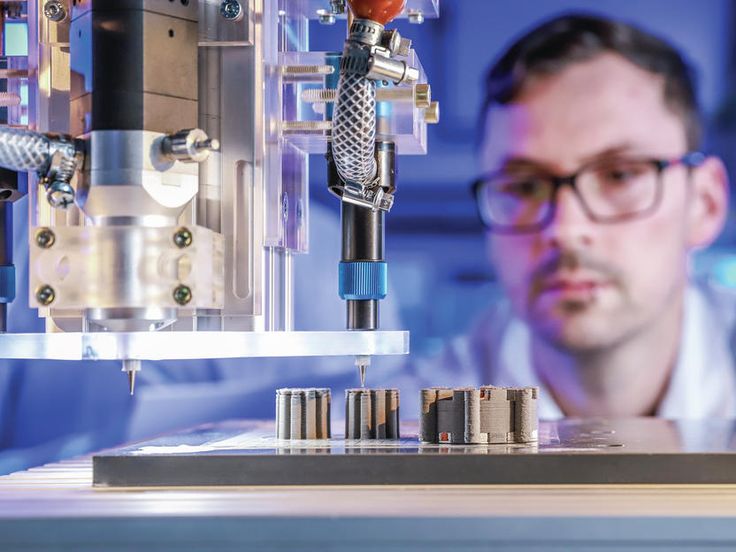 However, this doesn’t mean that you are restricted to these options, though, and we recommend that you explore all of these options we discussed when you next buy a 3D printer.
However, this doesn’t mean that you are restricted to these options, though, and we recommend that you explore all of these options we discussed when you next buy a 3D printer.
3D Printing Technology Guide
Today, there are about 10 major 3D printing technologies. They differ in speed, accuracy, material used and other parameters. The choice of 3D printing technology depends on the tasks that you set for the 3D printer, on the requirements for the resulting products.
- FDM/FFF
- SLA
- SLM
- SLS
- CJP
- PolyJet
- FDM0006
- SLM
- SLS
- CJP
- PolyJet
FDM (Fused Deposition Modeling) / FFF (Fused Filament Fabrication)
Operating principle: layer-by-layer construction of a product from molten plastic material.
Features:
- Various types of plastics (durable, flexible, heat resistant, etc.)
- Strength and durability of finished products
- 3D printers with large cameras
- Low cost and high productivity
More about FDM technology >>
FDM (Fused Deposition Modeling) / FFF (Fused Filament Fabrication)
Operating principle: layer-by-layer construction of a product from molten plastic material.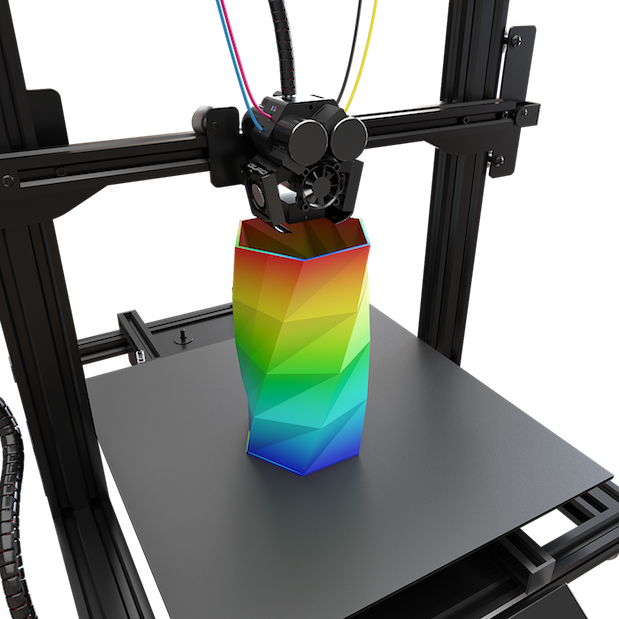
Features:
- Various types of plastics (durable, flexible, heat resistant, etc.)
- Strength and durability of finished products
- 3D printers with large cameras
- Low cost and high productivity
More about FDM technology >>
SLA (stereolithography)
Operating principle: layer-by-layer curing of a liquid polymer material under the action of a laser beam.
Features:
- Materials: polymer resins with different properties
- Laser curing
- High print speed
- High precision and detail
- Smooth surfaces
Learn more about SLA technology >>
SLA (Stereolithography)
Operating principle: layer-by-layer curing of a liquid polymer material under the action of a laser beam.
Features:
- Materials: polymer resins with different properties
- Laser curing
- High print speed
- High precision and detail
- Smooth surfaces
More about SLA technology >>
SLM (Selective Laser Melting)
Other names: DMP, DMLS, EBM, etc.
Operating principle: layer-by-layer fusion of metal powders under the influence of a laser
Features:
- Working with various metals and alloys
- Unique Product Features
- Any geometry
More about SLM technology and its analogues >>
SLM (Selective Laser Melting)
Other names: DMP, DMLS, EBM and others0003
Features:
- Working with various metals and alloys
- Unique Product Features
- Any geometry
More about SLM technology and its analogues >>
SLS (Selective Laser Sintering)
Operating principle: layer-by-layer sintering of polyamide powders under the influence of a laser
Features:
- Material: polyamide powders
- Any geometry
- Durability and precision
- High performance
Find out more about the SLS technology >>
SLS (Selective Laser Sintering)
Operating principle: laser-assisted layer-by-layer sintering of polyamide powders
Features:
- Material: polyamide powders
- Any geometry
- Strength and precision
- High performance
Learn more about SLS technology >>
CJP (Color-Jet Printing)
Function: layer-by-layer bonding and coloring of composite powder
Features:
- Composite powder based on gypsum
- 3D full color CMYK
- Realistic prototypes for visual evaluation
- Complex geometries
- Low cost
More about CJP technology >>
CJP (Color-Jet Printing)
How it works: layer-by-layer bonding and coloring of composite powder
Features:
- Composite powder based on gypsum
- 3D full color CMYK
- Realistic prototypes for visual evaluation
- Complex geometries
- Low cost
Learn more about CJP technology >>
PolyJet
How it works: curing liquid photopolymer material under UV radiation
Features:
- Photopolymer materials with different properties (transparent, rubber-like, biocompatible, etc.
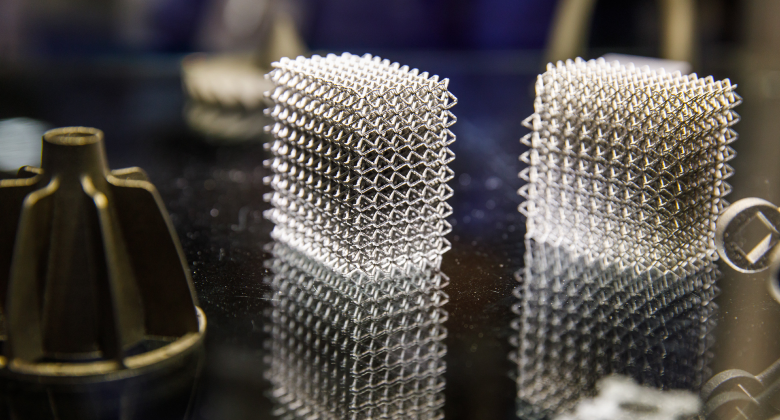 )
) - High detail, smooth surfaces
- Color 3D printing available
- Products do not require post-processing
Learn more about PolyJet technology >>
PolyJet
How it works: curing liquid photopolymer material under UV light
Features:
- Photopolymer materials with different properties (transparent, rubbery, biocompatible, etc.)
- High detail, smooth surfaces
- Color 3D printing available
- Products do not require post-processing
Learn more about PolyJet technology >>
We will help you choose a professional 3D printer the information I entered and I consent to the processing of my personal data in accordance with the privacy policy and user agreement.
New 3D printing technology from Stanford: 10 times faster than the fastest printer
Developments in additive manufacturing continue unabated. This time around, a new breakthrough from Stanford University will bring further innovation to the industry.
This time around, a new breakthrough from Stanford University will bring further innovation to the industry.
Stanford University engineers have created a 3D printing process that is 5 to 10 times faster than the fastest high resolution printer currently on the market and can use different types of resin to create a single object.
Results published in Science Advances on September 28. The high-resolution printing method allows researchers to use thicker resins with better mechanical and electrical properties.
“This new technology will help realize the full potential of 3D printing,” says Joseph DeSimone, Professor of Translational Medicine, Professor of Radiology and Chemical Engineering at Stanford, and author Joseph DeSimone.
"This will allow us to print much faster, helping usher in a new era of digital manufacturing, and will also allow us to produce complex objects from multiple materials in one step."
New design improves fluid interface continuous production, or CLIP, a 3D printing method developed by DeSimone and colleagues in 2015.
A rising platform gently removes what appears to be a fully formed object from a thin pool of resin in a process known as CLIP printing. While the layer of oxygen prevents curing at the bottom of the pool and creates a "dead zone" where the resin remains in liquid form, a series of UV images passing through the pool solidifies and assumes the correct shape of the resin.
The secret of CLIP speed is the dead zone. Liquid resin is designed to fill a solid object as it rises, allowing for smooth, continuous printing. However, this is not always the case, especially if the resin is exceptionally sticky or the object rises too quickly.
Researchers have placed syringe pumps on top of an elevating platform for this new technique, known as injection CLIP or iCLIP, to add extra resin at strategic locations.
"Resin flow in CLIP is a very passive process - you just pull the object and hope the suction can get the material to the right place," says Gabriel Lipkowitz, Ph.